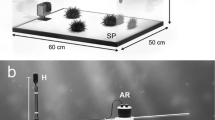Abstract
The circumpolar nudibranch Tritoniella belli Eliot occurs in abundance in shallow-water benthic communities of McMurdo Sound, Antarctica. Density estimates based on belt transects averaged collectively 0.46 individuals m−2 at three study sites between depths of 6 and 30 m in November 1996. At two of the sites, population densities increased linearly between 18 and 30 m depth (up to 0.7 and 1.15 individuals m−2 at 30 m depth). Individuals at all sites were rare or absent at depths shallower than 12 m. Size frequencies of individuals at the sites were similar, and a pooled analysis revealed a unimodal distribution skewed highly towards juvenile size classes. This suggests both recent recruitment and constant rates of mortality across size classes. The relationship between foot length and wet weight best fits an exponential growth equation, indicative of an allometric growth pattern. Distribution of T. belli in the field suggests that it is a habitat and diet generalist. Potential invertebrate predators include sea anemones and seastars, both of which co-occur in abundance in McMurdo Sound. Laboratory experiments indicate that the sea anemone Isotealia antarctica can capture and ingest T. belli. However, 70% of T. belli that are captured escape from the tentacles or, following ingestion, are rejected from the gastrovascular cavity. The seastars Odontaster validus, Perknaster fuscus, and Acodontaster conspicuus, avoid contact with T. belli, but if forced into contact with mantle tissues, retract their tube-feet. Mucus secreted from the mantle tissues, coated on to the tips of glass rods, and presented to seastar tube-feet, causes significantly longer tube-foot retraction times than control rods. Moreover, pieces of freeze-dried krill coated with mantle mucus are consumed significantly less often than untreated control pieces of krill by a benthic scavenging fish (Pseudotrematomas bernacchi). Employing seastar tube-foot retractions as a bioassay, we found the bioactive compound(s) are soluble in ethyl acetate, indicating they are lipophilic or moderately hydrophilic in nature. Chemical defenses in the mucus of T. belli probably contribute to its high abundance in Antarctic benthic communities.
Similar content being viewed by others
Author information
Authors and Affiliations
Additional information
Received: 6 October 1997 / Accepted: 24 March 1998
Rights and permissions
About this article
Cite this article
Bryan, P., McClintock, J. & Baker, B. Population biology and antipredator defenses of the shallow-water Antarctic nudibranch Tritoniella belli. Marine Biology 132, 259–265 (1998). https://doi.org/10.1007/s002270050391
Issue Date:
DOI: https://doi.org/10.1007/s002270050391




